









|
|
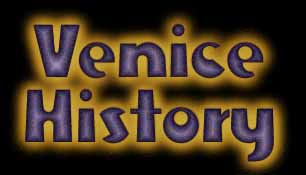
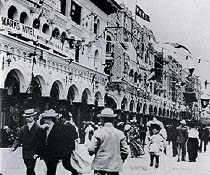

Birth of "Venice of America" (1890-1906)
In the 1890ís, one manís dream of a renaissance resort and amusement park transformed a deteriorating marshland west of Los Angeles, California, into the "Coney Island of the Pacific". Despite disbelief and opposition, the dreams of Abbot Kinney materialized in grand style.
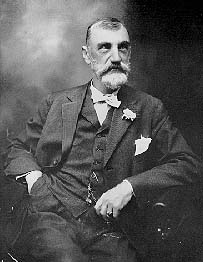 |
Abbot Kinney (1850 - 1920), father of Venice, California
|
|
The vision of Abbot Kinney, a wealthy tobacco mogul, world traveler and co-owner of the Ocean Park Casino and Resort, was to turn the land south of Ocean Park through the Del Rey peninsula into a "Venice of America." He envisioned a resort town culturally reminiscent of Venice, Italy, complete with canals, gondolas, amusement piers, hotels and Venetian-styled structures. With the Casino thriving, Kinney and his partners purchased all the land south of Ocean Park. After the partnership dissolved, the split was determined by a flip of a coin and Kinney won the toss. He chose the marshy southern half of the property. With his family by his side, Kinney set out to accomplish his goal.
|
In 1904, Kinney sent his building superintendent to the East Coast to visit various seaside resorts. Acquiring a landscape architect and town planner from Boston, Kinney and his staff drew up preliminary plans in June. Contracts were signed to dig up the half mile long, seventy foot wide Grand Canal and build the 900 foot long, 30 foot wide amusement pier at Windward Avenue. Construction began shortly thereafter. He then hired architects to design all the town buildings in "Venetian Renaissance" style.
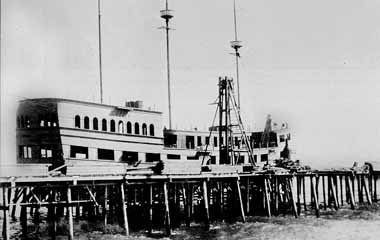 |
Building the Ship Cafe on the Abbot Kinney Pier, May 1905
|
In September, The Los Angles Pacific Co. enabled inland LA residents to visit Venice by completing the first electric trolley line. By the year's end, construction of the Ship Cafe and Auditorium, located on the Abbot Kinney Pier, the Venice Canals, and the St. Mark's Hotel on Windward were well underway.
All was running smoothly until two disastrous winter storms in February and March of 1905 demolished his newly built pier. As a result, the grand opening date was pushed back from May until July. Over 1000 workers worked around the clock to rebuild the pier, auditorium and Pavilion in time for the July 4th weekend rescheduled opening.
 |
Visitors rented canoes or hired gondoliers at the lagoon boathouse - The logoon today is the paved Venice circle
|
On June 30, ocean water, streaming in through two huge pipes, began flowing at a rate of 500 gallons a second thus filling the canal's central lagoon. With the majority of the canals filled and the pier completed, Venice, California was ready to celebrate. On July 4th weekend, the festivities featured something for everyone. Yacht racing, swimming races in the lagoon, band concerts, fireworks at the lagoon's huge 2500 seat amphitheater were some of the many events that amazed and wowed the 20,000 spectators. Although many of the resort hotels and attractions were not finished, the existing accommodations were sufficient and the tourists were enchanted. Venice of America was a success.
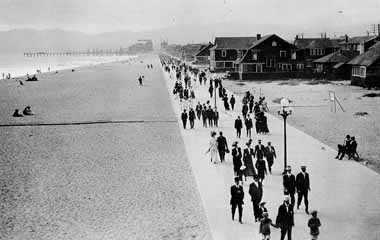 |
Ocean Front Walk in 1906 looking north to the Fraser Pier
|
With the canal network near completion and the adjacent residential lots sold, Venice began to grow at an enormous rate. The imported gondolas and the miniature railroad, which carted people in around the town, also arrived that summer. The town was booming and began attracting out-of-town sideshows and amusements.
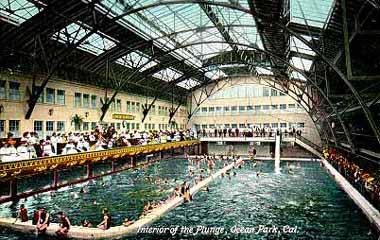 |
The Ocean Park plunge allowed visitors a choice of heated or ocean temperature salt water bathing
|
Excitement and Venice were synonymous. Roller skating soon became popular and a skating rink was built accordingly. The rink, located on Trolly Way (Pacific Avenue) fielded a roller hockey team which challenged teams from other California cities. Kinney also built a huge dance hall on the pier which could accommodate 800 couples. The Ocean Park Pier, just 3/4 of a mile north of the Kinney Pier, also had it's share of attractions including a $150,000 heated indoor salt-water plunge.
Back to the Venice Home Page...
This page was produced by the Westland Network
Copyright © Westland Network 1996-2009 - All Rights Reserved
|







